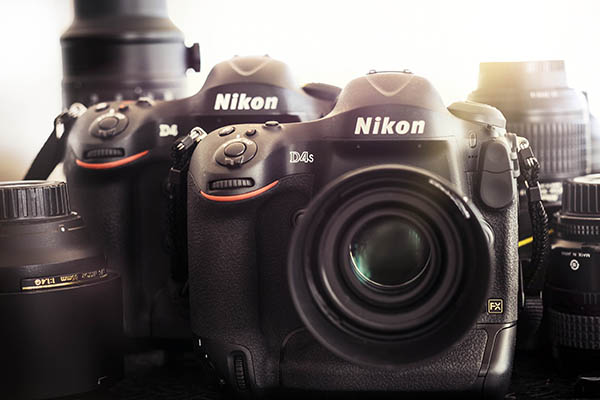 |
| Here is a Nikon D4s sitting on my studio equipment cart ready to go to work. |
Here are some of the improvements in the D4s:
- The 51-point autofocus system remains the same as the D4, however it adds a new Group Area AF mode grouping 5 points together to act as one unit to improve AF ability in confusing areas.
- The D4s shoots at 11fps with continuous AE and AF.
- The mirror assembly has been redesigned to accommodate the increased speed to 11fps and has a side benefit of keeping the mirror in its open position for a longer time between shots thereby minimizes the blackout time caused by the mirror in the up position.
- There is a new Expeed 4 processing engine, and while the megapixels remain at 16.1, it has been redesigned to work even better in low light so that a new top extended ISO speed of 409,600 has been added. The full range is 100-25,000 with extended from 50-409,600.
- The D4s takes a new battery, the EN-EL18a, to extend use time out to 3020 shots, up from 2600 from the older EN-EL18 with which it remains compatible.
- There is a new uncompressed 12-bit RAW mode for capturing smaller RAW files that are 1/2 the size of standard uncompressed RAW files. Handy if you want to speed up workflow or save storage space. In addition there is the standard 14-bit compressed and uncompressed files, JPEG, and TIFF.
- An auto-ISO feature has been added and works when the camera is in manual mode. I find this handy when I want to lock in a specific shutter speed and aperture combo and let the ISO float a bit to keep the exposure consistent, as sometimes needed with time-lapse photography.
- Addition of a 1080/60p video recording for up to 10 minutes at 42Mbps or 20 mins at 24Mbps
I found that the upper limit of the D4s without much, if any, correction for noise is about 6400 depending upon the lighting situation, of course.
 |
| Download a high res version of this image by clicking here. |
You might be able to get away with an ISO of 51200 after applying some noise reduction and improvement techniques in post processing.
 |
| This is an image shot at ISO 51200 with post processing corrections applied. Download a high res version of this file by clicking here. |
 |
| This is a full size crop from the image above it to show how the noise level from ISO 409600 appears. Have fun fixing that! |
The most obvious use of a camera like the D4s is fast-paced sporting events and wildlife photography. My own commercial work is different from that consists mostly of lifestyle photography, over 90% of which I currently do with a D4, often shooting over 4000 frames per day. I prefer working with available light and like to keep the models constantly moving to add a feeling of spontaneity to the resulting images. The excellent low noise and low light capability, superb auto-focus system, and super fast 11fps motor make the D4s an absolutely perfect choice for this type of shooting. The situations are similar to what a wedding photographer might face in candid shooting, or an events photographer working in low light. With this in mind I decided to test the D4s over four different lifestyle shoots with varying available light. Some of the results are below.
 |
| Photographed with a 35mm lens at f/1.4 |
Conclusion:
On paper the differences between a D4 and D4s appear so tame you begin to wonder why Nikon would even bother introducing a model change. But the D4 series is the workhorse cornerstone of many pro photographers, me included. It probably isn't a question of whether of not the changes are needed. Rather, it is more a question of whether or not the changes improve your workflow. For me, moving from 10 fps to 11fps is overkill. I still find the 9fps of the D3 more than sufficient. But there are photographers shooting fast action sports and wildlife for whom this improvement would be significant.
Working as I do in low light with high speed aperture lenses, my chief concern was with the improved AF of the D4s. This is one of the reasons I tested the D4s over several lifestyle shoots with dim back lighting. In these situations I know I am going to lose a large percentage of the take to missed-focus so I always overshoot the scenes as a way of bracketing the focus. The D4s was considerably better at delivering in-focus results in these situations, so much so that by the fourth lifestyle shoot I began feeling comfortable enough to cut back on my normal focus bracketing.
I also appreciated the faster write speed to high speed memory cards. This allowed me to keep on shooting while as long as the models continued to deliver the action. Having to ask the model to stop and wait while the buffer is transferring to the memory card is can be disruptive to the fluidity and mood of a scene.
Bottom line question is: Based on the improvements, would I trade in my D4 for a D4s? If there were enough life left in my D4, I would say probably not. The new conveniences of the D4s, while nice, are not something I absolutely need. If my D4 were older, then I would do the trade even though the newer D4s model is priced around $500 higher at $6496.95. The extra cost would most likely be made up down the road when the Nikon D5 comes out.
The lineage of Nikon flagship models, the D3, D3s, D4, and now the D4s, are absolute workhorses, and best of breed at what they do. In the hands of a working pro, this camera represents dependability and exceptional image quality under the worst circumstances you can throw at it, qualities that have endeared themselves to Nikon users since the original Nikon F.
 |
| 85mm lens at f/1.8 |
If you are planning on purchasing this camera, you can
help support this site at no extra cost to you by purchasing from one of our
affiliate sellers listed below -- and thanks for your support.










No comments :
Post a Comment